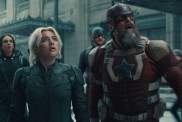A set report from Ti West’s fourth feature film

In the backwoods of Lime Rock, Connecticut – a rural area in the village of Lakeville – there resides a peaceful, stately home. As the sun begins to disappear behind the trees, we venture towards this house knowing that tonight it will be, as homes of this ilk sometimes are, the shooting site for Dark Sky Films’ low budget horror film House of the Devil.
Adjacent to the property is Trinity Episcopal Church, which the crew for House of the Devil has been using as a holding area. Upon arrival the publicist is quick to point out, “We’re at a church, so for obvious reasons, if anybody asks, the name of the movie is ‘The House’.”
“People are very touchy about the devil aspect,” says the film’s 27-year-old director Ti West. “We’ve been holding in that church and I don’t think they’d let us do that if they knew we were making a satanic movie. This has been a tough one. Lightning struck a tree right outside the house. Last night a light just blew up. I don’t know if I can recommend doing a satanic movie, it may have ramifications.”
Upon approaching the actual 19th century Victorian home (the “title character”) one can see several units of 25-foot high scaffolding surrounding the house, each with lights set up at the top pointing into the windows. Someone would tell me later this isn’t to simulate night-for-day but rather to provide the weird, creepy ambiance the director wants.
Also the film’s writer, West describes the basic thrust of the plot. “It’s a movie about a girl who wants to move out of her college dorm room, she doesn’t have a lot of money. She finds an apartment, and to make money for it she takes a babysitting job. She goes out to the babysitting job and the people are weird and it turns out it’s this cult.”
“It takes place in the ’80s because back then there was this ‘satanic panic,'” he continues. “Everyone believed there were these cults of crazy people that would worship the devil and sacrifice you and all these things. It wasn’t really true, but for some reason in the ’80s people believed in it. It was all over Phil Donohue and Geraldo. It was this weird phenomenon that wasn’t actually going on. This movie is like if the urban legend had been true. This is as far fetched as it could get.”
Many alterations had to be made to the location to create both the ’80s atmosphere and facilitate shooting. The homeowner decreed that certain fixtures could not be tampered with, so a wall had to be built to hide a refrigerator that didn’t match the period. Strips of wood-shaded linoleum were laid down to protect the actual wood floors of the 127-year-old home from the clomping mud-stained boots of the crew. Traces of blood on the floor and walls provide evidence of a previous night’s shooting, and having the publicist recount the events that took place here is not unlike a forensics expert taking me through a tour of a crime scene.
West, sporting a beard, looks a bit haggard from night shoots. This is the 19th day of production. “The first four or five days were [day shoots],” he says. “But the last 10 or 12 days, whatever the hell it is, have been night shoots. I prefer night shoots so it doesn’t bother me. I never know what day it is, but other than that I’d rather shoot at night. No one else likes night shoots, but I do because there’s no distractions, no one’s around. It’s like our own little club.”
Ushered up to the set by the 2nd 2nd Assistant Director Melinda (on walkie: “Hey, Zeke, I have a writer coming up.”), I am taken to the 1st AD Zeke, who places me in a cramped area toward the back of the set, where the crew works steadily to get everything ready for Ti West. The set is an attic space with tan walls and a slanted ceiling. The sparse room is dressed with cobwebs to give it that proper Coney Island Spook House look. Eliot Rockett, the Director of Photography, squeezes by in the cramped space.
Elliot shot Cabin Fever 2: Spring Fever with Ti as well. The $4.5 million dollar sequel to Eli Roth’s cult hit will appear on screens later this year, and could very well launch Ti into the same arena of simultaneous respect and revulsion that Roth has received since the Hostel films made him a major genre force. Eliot is very obliging to Ti, allowing him to camera operate on most shots. A camera assistant asks: “Eliot, are you operating this one or is Ti?” “Probably Ti,” says the DP. According to Eliot, Ti operates himself at least half the time, if not more, and he also edits the picture. Cleary this is a director who likes being involved.
Now, on the set, Ti calls down the stairs to his lead actress, Jocelin Donahue.
Ti: Hey Jocelin, I actually wanna do a quick rehearsal before you get bloody.
Jocelin: Okay.
This is the first day of the shoot where Ti has been sick. The director walks into the makeup room away from the crew to blow his nose. Anticipating the first shot of the day, he walks by Jade Healy, the production designer, and mutters, “And so it begins⦠goddammit.” Around 8:30pm they start the first shot of the day. “Smells like a barbershop in here,” says Ti. “Anyone want a plane ticket for Vegas? Leaves in 8 hours,” declares one of the crewmembers, who laments: “The hard thing about this industry is you can’t get away. If you plan something then something else will come up and it’ll fall apart and you lose money.”
Zeke: Quiet on the set and lock it up this is picture.

Jocelin is terrified, her face and legs are covered in blood. She rushes into the room in her bloody nightgown gripping a knife and slams the door behind her as Ti’s camera rushes toward her from the other end of the room. She then runs into the bathroom and slams the door shut. Ti frames the shot from a low angle to give it that extra bit of tension.
Zeke and Eliot watch from a portable handheld wireless monitor called a Lilliput, and like the denizens of Swift’s story it is small, the size of a car TV mounted in the driver’s seat. Zeke is watching for any mistakes.
Zeke: Tell Ti to watch for camera shadow.
3rd take
Zeke: Cut, boom in the shot.
Take 4
Zeke: That one looked good.
Ti: One more for safety.
Last take
Ti: Cut. Check the gate.
Zeke: Good gate. (shouts) That’s good gate, guys. Moving on.
“It’s been pretty intense⦠Jump in headfirst,” says Jocelin, who is enjoying her first lead role in a film, despite some trying emotional moments. “I won’t tell you exactly what happens, but there’s a really scary basement ritual scene. That was two days ago. I’m a little banged up, my knees and my back, but it was worth it. It was really REALLY intense, but the worst of it is behind me.”
Earlier I had sauntered down casually to the basement, where a chalk pentagram is drawn on the floor. Strange satanic symbols are visible behind wax-dripped candelabras on an altar. Antiquated parchments hung on the walls with archaic geometric images, and a black book at the altar’s center. Next to all this was a row of file cabinets with tax documents, also presumably satanic.
“Basically, what happens in the basement – and when you see it you’ll understand because it’s pretty trippy…” recounts the actress. “That was the first time I had the experience where I felt so overwhelmed that I couldn’t stop crying after the first take. Then you get used to it, what it’s going to feel like.”
In the make-up room rests a Styrofoam head with the facial appliance for a creature, a ghoulish, deformed old woman with an abnormally large space between her eyes on the bridge of the nose. The very non-ghoulish make-up girl Danielle dons this mask to become the hideous creature known as “Grandmother” who dwells in the aforementioned basement.
“There’s very few genre conventions,” continues Ti about his film. “It’s mostly a girl in a house being bored for most of the movie, because that’s what it’s really like when you’re babysitting. It’s her snooping through their cupboards and walking around, looking at their pictures. To some degree it’s almost boring, in a way almost like Repulsion or The Tenant, the weird stuff starts happening just as you’re on the brink of ‘what the fuck is going on?’ and then it starts happening and you realized you missed it all because you were lulled into it.”
Around 10:30pm I spy downstairs a couple crewmembers preparing the living room for the next day’s shoot, taping the entryway off so no one can disturb their handiwork. I ask them what they, as crew, look for in a director. They reply: “Appreciative and communicative are the two best things a director can be, never mind if he’s good at his job.”
Only a few years ago Ti was studying film as an undergrad at the School of Visual Arts in New York, where he was very self-motivated. He claims the teachers and curriculum at art schools tend not to encourage students to succeed, taking a very laissez faire attitude towards even the completion of student films. “It was like ‘Yeah, if you can get this finished that would be great, but if you don’t then we’ll give you a ‘B-‘ instead of an ‘A’.’ The only reason I accomplished as much thus far being young is because when I was a sophomore in school I had a movie in a festival that won an award. I just started doing all that stuff early. I’m not really patient, so I’ll make a movie a year one way or another.”
Amid the hubbub in the living room, a burly electrician, aka the “Juicer”, runs a long extension cord and plugs it into an outlet.
Author: What are you guys setting up for?
Juicer: It’s a scene that’s either going to shoot tonight or first thing tomorrow. She comes into the room and turns on a light⦠I hope I didn’t just ruin the end of the movie.

“I’m head of the art department,” says Jade Healy, who elaborates on her role in bringing the House of the Devil to life. “I work closely with Ti to come up with the visions for everything, as well as being the sole buyer. I pick the wallpaper, all that kind of crap. Everything you see, basically. The set dressing so determines a lot of the action in this film because the first half of the film is just her walking around.”
“What Jocelin was going to do depended on what I put in the room,” she adds. “Like in the boy’s room I brought a fishbowl with a fish and I put a huge mural up, and that became the central part of the room. She goes in, she looks at the fishbowl and she looks at the mural. Ti asked me to buy lots of knickknacks, interesting fun things for her to pick up and do stuff with. It’s neat when the set dressing becomes central, and the house itself is so central to the film. It’s just nice. Ti likes little fun things, he likes things that make him think of when he was a kid. It’s always like ‘my dorm room’ or ‘can I get a popcorn machine that I had when I was a kid.’ It’s always sort of recreating this childhood that Ti had. He’s very nostalgic about a lot of things.”
Midnight. They are about to start a new scene with Mary Woronov, the great camp actress familiar to most from Paul Bartel’s movies and as the evil principal in the classic Rock ‘n’ Roll High School. Mary is one of the two evil parents in the film, the other played by the always-intimidating Tom Noonan of Manhunterfame.
“It’s strange,” says Mary describing the movie, her character, and possibly life on a film set. “We just appear as a family and take over this house and then say we need a babysitter. Obviously she is the person the devil wants to impregnate. That was our mission, to find someone so we can set her up to do this. We appear as a family. Our son [played by The Signal‘s A.J. Bowen], who’s completely nuts, the mother and the father, and then the grandmother who no one sees. It’s funny because we act very normal, and yet you can tell things are not normal.”
The set is too crowded for me to watch in-person, so I am in another room on the second floor where a monitor is set up for two of the film’s producers, Josh Braun and Roger Kass, who made A History of Violence together. They picked this story from four or five that Ti pitched to them. In the scene, Mary drags Jocelin out of the bathroom and begins a crazed monologue like a woman possessed.
Mary: It can’t be stopped now. No matter what you do⦠it won’t stop. It’s almost over. It’s all going to work, you’ll seeâ¦then you will understand, everyone will then.
“I know what I like in a director,” Mary mused earlier during our interview. “But I’m sure it’s not what lasts in this business. This business is very tricky. I came from Andy Warhol and the Theater of the Ridiculous, and then I came into Corman. The kids who were with Roger Corman, they did these movies that were really cheap, everybody worked together, and the directors usually let me do what I do. Then I started doing more Hollywood movies and the directors get more narrow, narrow, narrow ‘You can only do this.’ Ti is not like that. Ti wants you to do what you do, and that is a good mark as a director as far as I’m concerned.”
There is a sense of fun and tight-knit camaraderie among this crew. Two female camera assistants avidly flip through an issue of In-Style between set-ups. A random crewperson standing by the stairwell banister tells me a secret: “Did you know this part of the house is haunted? The property master cut the nastiest fart right thereâ¦and I can still smell it.”
Josh and Roger continue to watch the scene play out in the monitor. The film, which has been shot in sequence, cost between $500,000 and $1.2 million dollars. The two producers say that one of them is usually here every night. They trade off. The pair like what they see, and they hope the Toronto Film Festival will as well. A third person sits by the monitor watching all the takes with a clipboard in hand. “The takes that are good I circle so we can print them,” he says. “Even though we’re printing everything on this show. At least they’ll know.”

On the 7th or 8th take Jocelin does a little curtsey after her take with Mary, which cracks up the crew. Around 12:30-ish the 2nd 2nd Melinda says what everyone undoubtedly wants to hearâ¦
Melinda: Cut, checking the gate. On a good gate that’ll be lunch⦠It’s a good gate.
Author: Mmm, dinner.
Melinda: Actually, it’s called lunch.
Author: Isn’t that semantics?
Melinda: Oh I forgotâ¦you’re a writer.
Ti West is making his fourth feature film, after The Roost (a farm-based horror flick), Trigger Man (a “Most Dangerous Game” hunter-becomes-the-hunted movie), and Cabin Fever 2. He is clearly locked into a trajectory in filmmaking that will take him to interesting places, possibly outside of genre movies, but for now he is reveling in being more prolific in his formative years than some directors ever get to be.
“I think too many people wait around for the big payday to come in,” says Ti. “If you’re lucky enough for that to happen you should at least stay busy in the meantime. Work begets work. If I had not made The Roost then nobody would know about this movie. If I had not done Trigger Man in between then I wouldn’t have been doing anything for that year, I wouldn’t have had festivals. Then the ‘Cabin Fever’ thing happened, and that helped motivate this to happen. It’s good to stay busy. I have a goal to try to get five completed and distributed features before I turn thirty⦠Maybe we’ll try to go for six.”
At 1 a.m. everyone is gathered in the main hall of Trinity Church seated at several long tables, convivially chatting and gnawing on pork roast. Ti, who never seems to stop, is giving Mary notes on the arc of her character, referring to some kind of chart/outline on his lap. Seeing the crew of House of the Devil eating in the House of God, enjoying the warmth of each other’s company while Ti West methodically plans the next bit of debauchery to be filmed, one cannot help but think: “Hallelujah.”
Source: Max Evry










